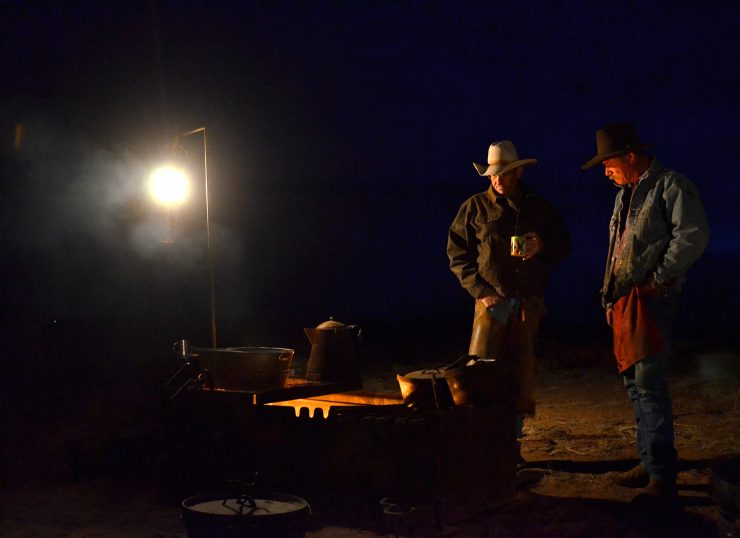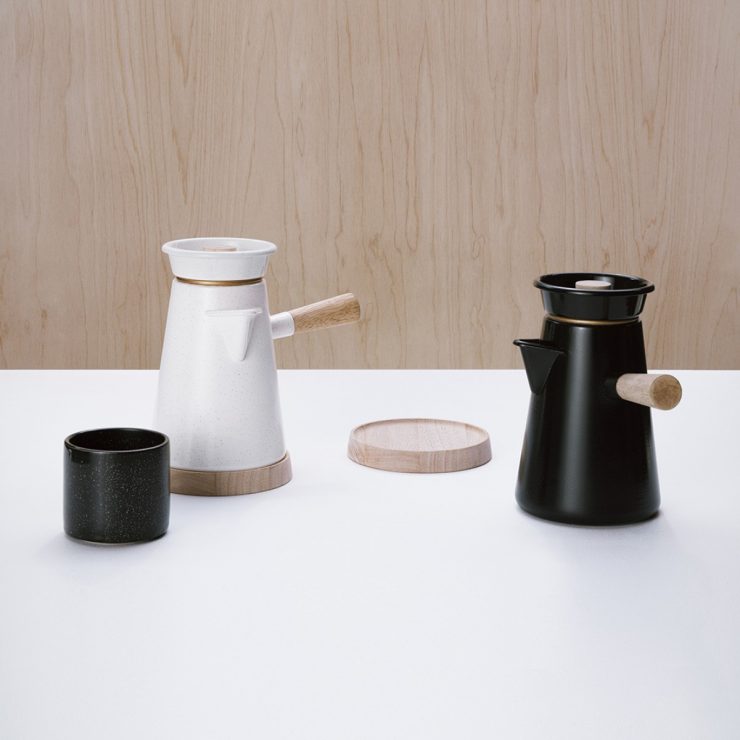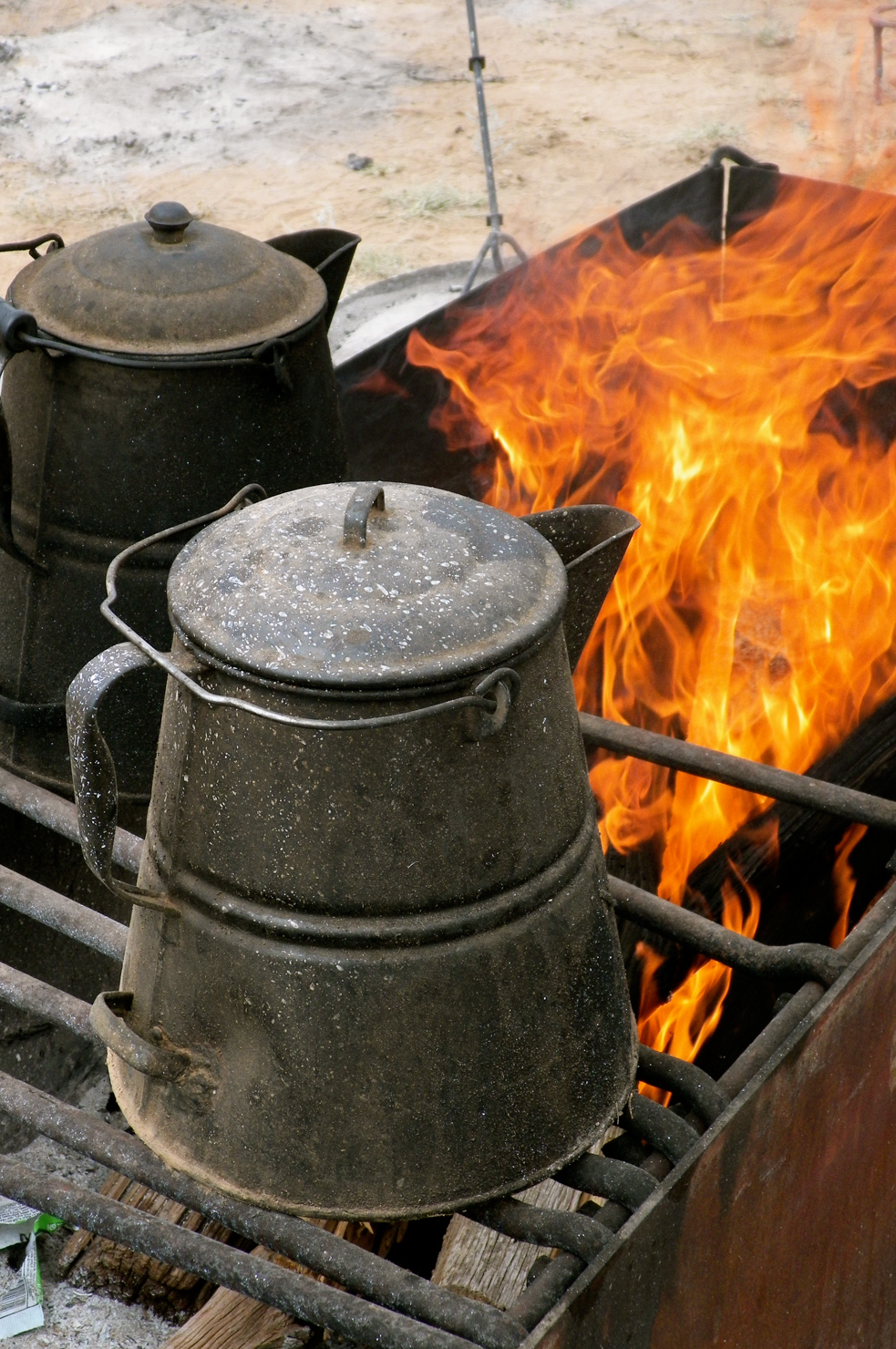
Drinking coffee by the fire. (Photo by Shannon Keller-Rollins)
What do the words “cowboy coffee” bring to mind? A campfire? A blue and white-speckled kettle? A rough, sludgy cup o’ joe? Whatever you think about cowboy coffee, if you’re in the specialty-coffee world, it probably isn’t positive. Yet cowboy coffee nonetheless has a lot of devotees. What gives? I decided to get educated and call an expert: a cowboy.
“Pardon the cows in the background, ma’am,” says Kent Rollins over the phone, where I catch him at home in southwestern Oklahoma. Rollins is a cowboy, chuckwagon cook expert, cookbook author, and coffee lover.
“I hope people don’t get the impression that it’s dark, with the spoon standing up in it,” says Rollins, pointing out that if cowboy coffee is brewed right, it should be smooth and pleasantly drinkable. So much so that “most everybody drinks it black,” he adds. “I’d say 95% of the people will tell me, ‘This is the only time in my life I ever drank coffee with nothing in it.’ ” Sounds similar to what you hear in the specialty-coffee world, doesn’t it? In fact, with their absence of frilly creamers and flavored syrups, specialty coffee and cowboy coffee have more in common than you might assume.
Intrigued by the idea that cowboy coffee could be more tolerable than what the average coffee person was used to drinking, I went to Joseph Rivera of Coffee Chemistry to see if there might be a scientific explanation for it. For one thing, he says, it could have to do with the coffee used—in Rollins’ case, Folgers. “In using coarse coffee, you will not get full extraction from the grounds, which [means] a weaker brew that is ultimately less bitter,” says Rivera. “The bottom line is that the level of total dissolved solids would likely be quite low in this type of coffee, which would explain the ‘smoother’ [or weaker] taste in the cup.”
Off the ranch, of course, cowboy coffee has a bad reputation. “I think [that] comes from the unrefined, DIY aspect of it,” says Vaughn Robison, a commercial art director and, yes, a cowboy. “Cowboy coffee is to the coffee world what grunge music was to classic rock: they both serve somewhat the same purposes, but one does so while rejecting well-developed systems of process and taste.”

Castor Cowboy Coffee Kettle (Photo courtesy Castor Design)
Which can also be a selling point. “We felt coffee culture was getting a bit out of hand,” says Brian Richer of Castor Design, which made the Cowboy Coffee Kettle, a fashionably minimalist brewing system that would look as much at home in a Brooklyn cafe as on the ranch. “We wanted to simplify things, bring things back to basics. Hot water, coffee, and time—that’s it.” For Richer, the allure of cowboy coffee is exactly that simplicity. “The grind is easy to achieve without expensive grinders, and no filters are needed,” he says. “It’s an elegant, straightforward process.”
Brewing cowboy coffee is an art
Rollins’ formula for making a good cup is also pretty straightforward. “You get one of them big coffee pots,” he says (his pots are big, with room for about two gallons of water), “and add about a cup and a half of coffee when the water warms.” When the water comes to a rolling boil, you take it off the heat. “I’m talking rolling,” says Rollins.
Rollins pours about a cup of cold water into the spout. In the cowboy-coffee-making crowd, this step is key, as it helps the grounds settle to the bottom. According to Rivera, this also helps with the taste, since adding cold water “would effectively stop the extraction process altogether.” As long as there was just enough time to extract the most soluble compounds from the grounds, this could lead to a pretty decent extraction.
The cold-water step is where recipes on cowboy coffee can differ. Some call for crushed eggshells, which help the grounds to sink faster to the bottom, and because eggshells are alkaline, they can also reduce the acidity levels. There’s also the sock method: putting your grounds in a sock to act as a filter. Rollins has strict opinions on both of these things. “Who wore the sock before you put it in?” he asks, before adding, “I like my eggs and coffee separate.”
When I think of cowboy coffee, I immediately think of a cup full of grounds. But “when you get grounds in your coffee it’s not made right,” says Rollins. Even without grounds, some people might be averse to traditional cowboy-coffee preparation because of the inconsistencies inherent to it. “I think it’s similar to why people in the specialty world are not into French press as much as pour-overs,” says Suyog Mody of Brooklyn’s Driftaway Coffee, which happens to have a guide to brewing cowboy coffee on their website. “The contact time and extraction is not as controlled by the person brewing.”
I gave Rollins’ method, as well as Castor’s Cowboy Coffee Kettle-approved method, as explained by Sam James of Sam James Coffee Bar, a try. While Rollins boils the water with the grounds in it, James’s method boils the water first, then adds the coffee. I happen to prefer the latter, but overall, I was surprised at how good both of them tasted (I’ll be honest, it could have been the Kenya Kiandu AA from Augie’s), even with the grit of a few straggling grounds that refused to be settled by the cold water.

Brewing up some cowboy coffee (Photo by Shannon Keller-Rollins)
Cowboy coffee’s historic and cultural allure
While Rollins has perfected his grounds-to-water ratios and boiling time, his attention to detail seems to be a more modern development. According to the book Western Words: A Dictionary of the Range, Cow Camp and Trail, published in 1945, an old-time wagon cook had this as a standard recipe: “Take two pounds of Arbuckle’s coffee, put in enough water to wet it down, boil it for two hours, then throw in a hoss shoe. If the hoss shoe sinks, she ain’t ready.”
Arbuckle’s was a popular brand in the late 1800s and early 1900s, and still exists today. Before Arbuckle’s, general stores carried green coffee beans, which consumers would roast themselves, often over a fire. Pre-roasted, pre-ground, and sold in airtight one-pound packages, Arbuckle’s made coffee brewing a more simple affair for Westerners, and revolutionized the industry—whether or not it was thick enough to hold up a horseshoe.
It’s not hard to understand why this style of coffee has held its allure. “I think the cultural draw [of cowboy coffee] is largely something that comes from either die-hard cowboys looking to preserve archaic, cultural touch points of a utility-based way of life, or those who live outside the Western lifestyle but also see it as a dying craft to be preserved,” says Robison. “The second group, who have a tendency to romanticize and lust after the Western way of life, is also largely responsible for the fetishization of the method and its resurgence in popular coffee culture.” He’s also quick to point out that overromanticizing things is not necessarily the cowboy way. “I can guarantee you that the vast majority of modern cowboys brew a pot at home and put it in a Thermos before heading to work. This is 2016 after all, and convenience is key.” An image of a battered kettle atop a fireplace alongside a coffee drinker wrapped in a Pendleton blanket may look cool in this Instagrammed world, but it’s not necessarily the definition of authenticity.
Which is exactly what makes someone like Rollins so appealing, to cowboys and non-cowboys alike: he is the real deal. His authentic passion for a good brew done in a traditional way is compelling. “If you look back in history, there has never been a more iconic figure than a cowboy,” he says. “Folks…get a little nostalgic with it, to say, ‘I’m having cowboy coffee.’ ”
“Like many other coffee moments, I think it’s all about where you are, how you are feeling at the time, who you are with,” says Mody, who acknowledges that the only time he has brewed cowboy-style coffee has been on camping trips when he has forgotten his AeroPress. “For me, cowboy coffee is about time outdoors, cold mornings trying to warm up, etc.”
As with most regional coffee-drinking customs—be it a Turkish coffee in Istanbul, a traditional Swedish fika at an old cafe in Stockholm, or a sugar-laced espresso in Havana—the love for cowboy coffee is as much about the custom as it is about the drink itself. There’s “a cultural component to a cup of coffee and shooting the shit over it with other cowboys,” says Robison. “Visit any small town in western America and you’re sure to find at least two old cowboys at any diner spending too much time talking about cows over cups of cheap coffee pumped from an air pot.”
While Rollins and I may differ in what kind of coffee we like to brew (he’s a devoted Folgers man, I’m more of a Heart kind of girl), isn’t coffee all about putting love into what you brew and enjoying it with other people? So if that’s also the essence of cowboy coffee, then it’s something I can definitely get behind. “I love talking about coffee,” says Rollins as we’re about to hang up. I wish him a nice evening, and he responds, “I hope someone buys you a cup of coffee tomorrow.”
I kind of hope someone makes me some cowboy coffee instead.
A Recipe for Cowboy Coffee
via Sam James/Castor Design
“This method won’t have the clarity of a filter coffee, but it’s very flavorful and rich,” says James.
1. For every cup of coffee [about 8 ounces/240 ml] you want, use 2 tablespoons [12.5 to 14 grams] of coarsely ground coffee, roughly the size of coarse salt.
2. Add as many cups of water to the pot as needed and heat to a boil. Once boiled, turn heat off and let water settle for 30 seconds before adding coffee.
3. Spoon the grinds directly into the water, stir, and let sit for 5 minutes.
4. After 5 minutes of brewing, stir the coffee or swirl the pot gently, and pour coffee slowly. If you would like less grit in your coffee, wait an extra 5 minutes after stirring.
Cowboy coffee time. Taking a break. Hope you’re all having a great day. pic.twitter.com/ccVsYBeG0w — Paladin (@M551Sheridan) January 14, 2016
Anna Brones (@annabrones) is a Sprudge.com staff writer. Read more Anna Brones on Sprudge.
The post The Lonesome Art Of Cowboy Coffee appeared first on Sprudge.

